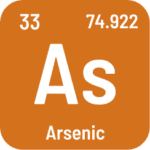Table of Contents
What is ARSENIC (As)?
 Arsenic (As, Latin arsenicum) is a chemical element belonging to the XV group of the periodic table, known as the nitrogen group. It exhibits characteristics between metals and nonmetals, and its chemical compounds are highly toxic.
Arsenic (As, Latin arsenicum) is a chemical element belonging to the XV group of the periodic table, known as the nitrogen group. It exhibits characteristics between metals and nonmetals, and its chemical compounds are highly toxic.
Arsenic is found in the Earth’s crust and is dispersed in various minerals, primarily in the form of sulfides such as orpiment and realgar, as well as arsenosulfides such as arsenopyrite and arsenides. Arsenic forms chemical compounds with both metals and nonmetals, in which it occurs at different oxidation states: -III, 0, +III, and +V.
Importance of arsenic in seawater
Arsenic also occurs in the natural marine environment, but in amounts close to zero. At higher concentrations in saltwater, arsenic can have a negative impact on marine animals. Its presence in a saltwater aquarium indicates contamination with this element.
Dangers related to the presence of arsenic in seawater
A high level of arsenic in saltwater is undesirable, although its exact impact on marine animals is not fully understood. The toxic effects of arsenic are noticeable at concentrations of 15-20 µg/L in saltwater. Initially, corals may lose some tissue, and prolonged exposure to high concentrations of arsenic can lead to coral death.
How to protect your aquarium?
It’s important to regularly monitor the arsenic content and maintain it at an undetectable level, around 0 µg/L. The absence or low levels of arsenic (around 0.1 µg/L) in saltwater ensure the health and vibrant coloration of marine animals. The most accurate and reliable method for arsenic detection is through ICP-OES analysis. Inductively Coupled Plasma Optical Emission Spectrometry (ICP-OES) is the most precise analytical method for determining the elemental composition of seawater.
Recommendations
To ensure the appropriate level of arsenic in your aquarium, you should regularly test it and ensure its appropriate level.
When arsenic levels are above 0 µg/l, it can lead to health problems in corals and other animals, and even to their death. The most common reasons for exceeding the recommended arsenic level are:
- contaminated salt,
- scale,
- glues,
- frozen foods,
- plastics.
Find and eliminate the cause of the problem and reduce the value of this parameter in the water. Perform up to 6 water changes. It is recommended to replace about 15% of the aquarium water each time until the recommended value of this parameter is achieved. The water prepared for replacement must have the appropriate target salinity level. Use salts with the correct parameters and composition for conducting the ICP test.
Summary
Arsenic is present in both the Earth’s crust and the marine environment. Its dual nature, oscillating between metal and non-metal, as well as its highly toxic chemical compounds, make it an element worth considering in the context of saltwater aquariums. High concentrations of arsenic can have a negative impact on the health of marine organisms, especially corals. Therefore, precise monitoring and maintaining arsenic levels as low as possible are crucial for preserving the health of the saltwater aquarium ecosystem.
*nitrogens – the name nitroides comes from the name of the first element placed at the top of the fifteenth column of the periodic table (N-nitrogen). This group includes elements with similar properties.
About author

Magdalena Metzler
Privately, I am a mother and a lover of nature and sport. My main interest is quantum chemistry, which hides a whole lot of unsolved mysteries and connections, which is extremely exciting from a scientific point of view.
In my scientific career, I have conducted international projects focused on innovative solutions for many branches of business, e.g. automotive, construction, and now, of course, marine aquaristics.
Working at Reef Factory gave me a passion for marine aquaristics, which I can develop every day, building a chemistry department and creating products that will help aquarists take care of tanks and ensure the highest safety of animals. One of the most exciting memories of working at Reef Factory is the commissioning of the ICP-OES spectrometer, which analyzes the elemental composition of seawater. The method of analysis in ICP is based on an analytical technique, which is a combination of my passion for quantum chemistry and marine aquaristics.
I hope you find my articles on ReefPedia interesting and helpful! Happy reading :))

